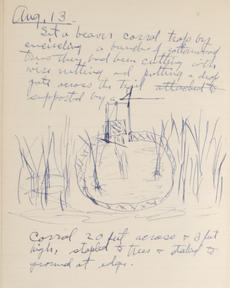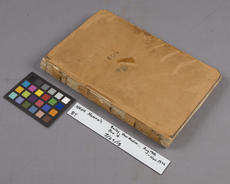 During my summer working on the field book project with the Smithsonian Institution Archives, I was able to go behind-the-scenes at the National Museum of Natural History to help survey collections in the Divisions of Birds, Mammals, and Fishes; and the Departments of Entomology and Botany. While surveying, we briefly assessed the condition of each book to obtain a rough idea of the condition of the objects and to make an estimate of how long they will take to treat. I particularly enjoyed surveying, because the field books are full of surprises, and we never knew what drawings, specimens, or photographs we might encounter. In the Division of Mammals field book collection, I came across a mysterious drawing of a "beaver corral" in one of Vernon Orlando Bailey’s many field books, and was inspired to learn more about Bailey while repairing this book.
During my summer working on the field book project with the Smithsonian Institution Archives, I was able to go behind-the-scenes at the National Museum of Natural History to help survey collections in the Divisions of Birds, Mammals, and Fishes; and the Departments of Entomology and Botany. While surveying, we briefly assessed the condition of each book to obtain a rough idea of the condition of the objects and to make an estimate of how long they will take to treat. I particularly enjoyed surveying, because the field books are full of surprises, and we never knew what drawings, specimens, or photographs we might encounter. In the Division of Mammals field book collection, I came across a mysterious drawing of a "beaver corral" in one of Vernon Orlando Bailey’s many field books, and was inspired to learn more about Bailey while repairing this book.
The "beaver corral" drawing is one of only a handful in this book, and provides an important record of Bailey's work. As was mentioned in a blog post by cataloging intern Jenny Mathias, Bailey was a pioneer in the creation and use of humane animal traps, which were designed to catch animals alive and uninjured. Bailey even received prizes from the American Humane Association for his traps, and published literature related to beavers, including Beaver Habitat and Experiments in Beaver Culture and Ways of the Beaver People. However, this particular beaver trap was not made for research purposes, but was instead built for a "Mr. Adams" who was interested in selling the beavers to "ranchmen" for stocking streams at a price of $50 for a single beaver or $100 a pair.

In his career, Bailey traveled throughout the United States, mainly researching small mammals, and was often accompanied by his wife, Florence Merriam Bailey, who was a renowned ornithologist. This particular field book chronicles his adventures in Oklahoma, New Mexico, and Texas from August 1906 to November 1906. Bailey not only includes notes related to his research, but also provides a detailed account of the vegetation, weather, geographic features, and people he encountered along his journey. He also mentions his meals, including a supper of "prairie dog & rabbit…& fried owl…& bacon…" and comments that the prairie dog tasted better than the owl! While in New Mexico, he traveled past numerous mesas and pueblos. After a particular visit to the Acoma Pueblo which was occupied by a Native American community at the time, he comments that "…it is will only a matter of time till they will come down and leave it." However, Bailey’s prediction thankfully proved to be wrong; Acoma Pueblo remains among the oldest continually occupied pueblo communities.
 Many of Bailey’s field books look nearly identical to the one pictured here, and many of them are in a similar state of disrepair; the covers are detached, the leather covering the spine is at least partially lost, and there are a few loose pages. The leather has also become degraded, and flakes off when the book is handled, which leaves quite a mess. In order to make this book safe to digitize and handle without causing further damage, I first removed the flaking remains of the leather spine covering, so that I could consolidate the text block with a lining of lightweight Japanese paper and wheat starch paste. I then reattached the loose pages and stabilized the loose covers with hinges of Japanese paper and wheat starch paste. It is now housed in a custom-made, polyester cover to prevent further loss of the leather, and is much safer to handle.
Many of Bailey’s field books look nearly identical to the one pictured here, and many of them are in a similar state of disrepair; the covers are detached, the leather covering the spine is at least partially lost, and there are a few loose pages. The leather has also become degraded, and flakes off when the book is handled, which leaves quite a mess. In order to make this book safe to digitize and handle without causing further damage, I first removed the flaking remains of the leather spine covering, so that I could consolidate the text block with a lining of lightweight Japanese paper and wheat starch paste. I then reattached the loose pages and stabilized the loose covers with hinges of Japanese paper and wheat starch paste. It is now housed in a custom-made, polyester cover to prevent further loss of the leather, and is much safer to handle.
Related Resources
- Texas Natural History: A Century of Change, 2002, by David J. Schmidly
- Mammalogy at the Intersection of Mercy and Truth, Field Book Project blog
- Vernon Orlando Bailey, 2007, by Perry, Bond, and Lohnes. Washington Biologists' Field Club.
- Official Pueblo of Acoma
Related Collections
- Record Unit 7267 - Vernon Orlando Bailey Papers, 1889-1941 and undated, Smithsonian Institution Archives
Produced by the Smithsonian Institution Archives. For copyright questions, please see the Terms of Use.

Leave a Comment